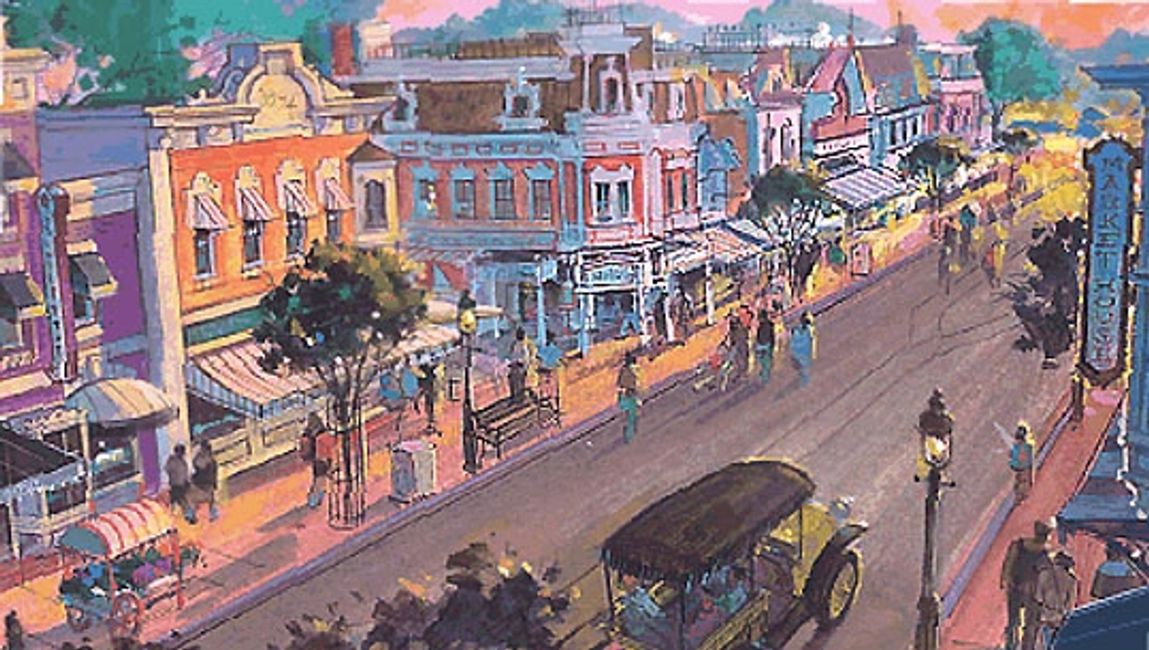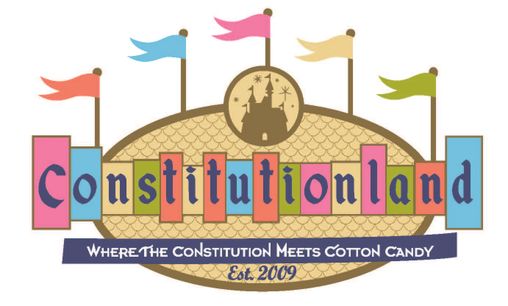
Preamble Street
Welcome to your gateway to Constitutionland, themed around the most famous preamble. As you enter, look up, the MAIN ENTRANCE is the world's largest copy of the US Constitution. Just past the entrance is Constitutionland's Preamble Square, our town square, where most of our presentations and speeches are held. Have you taken a picture with Mr. Textualism or James Madison, yet? Don't worry, you will see them and many of our other characters throughout the day. It's sort of our front parlor too, note the numerous benches and shady seating areas which allow our guests to rest their feet, have a cool drink and debate the constitutional issues of today and yesteryear. Look out, Constitutionland's Great Orators and Great Dissenters love to mill around among these restive places to strike up a good debate. At the center of Preamble Square, look down to see emblazoned in giant letters, the words that kick off the US Constitution:
__________________________________________________________________
"We the People of the United States, in Order to form a more perfect Union, establish justice, insure domestic Tranquility, provide for the common Defence, promote the general Welfare, and secure the Blessings of Liberty to ourselves and our Posterity, do ordain and establish this Constitution for the United States of America."
__________________________________________________________________
To start your day, enter WE THE PEOPLE: THE AMERICAN JOURNEY where you will experience who "we the people" has represented over the centuries, and what it means today. As you walk down Preamble Street, the main thoroughfare in Constitutionland, you will come upon "A MORE PERFECT UNION: RESEARCH CENTER" an academic facility for our guests who hope to enhance their research and understanding of the Constitution. Next up, on both sides of the street are the "ESTABLISH JUSTICE GIFT SHOP", "DOMESTIC TRANQUILITY REST AREA", and ""THE COMMON DEFENSE" and "GENERAL WELFARE" restaurants. Finally, welcome to "THE BLESSINGS OF LIBERTY THEATRE" where you can see Constitution themed theatrical productions throughout the day and into the evening. Would you like to learn more about the Preamble? See below.
Remember, Preamble Street is ONLY THE BEGINNING...you have seven more lands to discover!
We the People: The American Journey
Have you ever wondered what the phrase "We the People" means? Who does it include? "We the People: the American Journey" attempts to answer that question....
Learn about the Preamble
Would you like to learn more about this most famous paragraph in American history? Well, buckle your seat belts...
What is a Preamble?
"An introductory statement in a constitution, statute, or other document explaining the document's basis and objective; esp., a statutory recital of the inconveniences for which the statute is designed to provide a remedy. (From Black's Law Dictionary, Eighth Edition).
Birth of the Preamble to the US Constitution
On August 6, 1787, Mr. John Rutledge, of South Carolina, head of the Committee of Detail presented the first complete draft of the United States Constitution. The Committee of Detail had been created on July 23, 1787, for the purpose of organizing the various resolutions and ideas which had taken shape throughout the course of that summer.
There were five members of the Committee of Detail: Mr. John Rutledge of South Carolina, Mr. Edmund Randolph of Virginia, Mr. Nathaniel Gorham of Massachusetts, Mr. Oliver Ellsworth of Connecticut and Mr. James Wilson of Pennsylvania. (See Madison's Notes on the Debates in the Federal Convention for July 23, 1787 at http://avalon.law.yale.edu/18th_century/debates_723.asp).
On July 26, the Federal Convention "unanimously Adjourned till Monday, August 6 that the Come. [Committee] of detail might have time to prepare & report the Constitution." (See "Madison's Notes on the Debates in the Federal Convention" for July 26, 1787 at http://avalon.law.yale.edu/18th_century/debates_726.asp).
In this first complete draft of the new Constitution, the preamble appeared as follows:
"We the people of the States of New Hampshire, Massachussetts, Rhode-Island and Providence Plantations, Connecticut, New-York, New-Jersey, Pennsylvania, Delaware, Maryland, Virginia, North-Carolina, South-Carolina, and Georgia, do ordain, declare, and establish the following Constitution for the Government of Ourselves and our Posterity." (See "Madison's Notes on the Debates in the Federal Convention" for August 6, 1787 at http://avalon.law.yale.edu/18th_century/debates_806.asp).
James Wilson is credited as the author of this first, mundane version of the Preamble. (From David O. Stewart, The Summer of 1787: The Men Who Invented the Constitution p.169)
Compare the Preamble to the Articles of Confederation
The Articles of Confederation, drafted in 1777, and ratified as the form of government of the United States of America since March 1, 1781, began with a preamble similar in style:
"To all to whom these Presents shall come, we the undersigned Delegates of the States affixed to our Names send greeting. Articles of Confederation and perpetual Union between the states of New Hampshire, Massachusetts-bay, Rhode Island and Providence Plantations, Connecticut, New York, New Jersey, Pennsylvania, Delaware, Maryland, Virginia, North Carolina, South Carolina and Georgia."
Customarily, a preamble lists the law's objectives, which is not the case in the preamble to the Articles of Confederation or the first draft of the preamble to the US Constitution. That, of course, is not the end of the story.
The Preamble Evolves: The Committe of Style and Arrangement
On September 8, 1787, with the convention quickly drawing to a close, a "Committee was then appointed by Ballot to revise the stile of and arrange the articles which had been agreed to by the House." The members of the committee were William Samuel Johnson, Alexander Hamilton, Gouverneur Morris, James Madison and Rufus King. These five men were known as the Committee of Style and Arrangement and it was their job to organize the layout of the numerous resolutions that had already taken shape and formed the new Constitution. (See "Madison's Notes on the Debates in the Federal Convention" for September 8, 1787 at http://avalon.law.yale.edu/18th_century/debates_908.asp).
Although it was a five man committee, the chairman, William Johnson, asked Gouveneur Morris to write the final draft. Remember, the committee meetings were not documented as the convention was, but both Morris and Madison confirmed the latter's authorship. (From David O. Stewart, The Summer of 1787: The Men Who Invented the Constitution p.232).
Origins of "We the People"
The phrase "We the People" has taken on a mystical quality in political history. The very concept of "the People" as the authors of this new Constitution created, in history, an element of revolution, especially considering the era in which these words were written, when most other governments in the world were ruled by, at best, constitutional monarchies, and at worst tyrannies. The birth of this phrase is not quite as miraculous as one would expect, however.
When Morris sat at his desk in Mrs. Baily's rooming house on Market Street, where he resided during the Constitutional Convention, to polish up the Constitution, he was unsure whether all of the states would ratify it. With Rhode Island never in attendance at the Convention and the delegates from New York (besides Hamilton) having gone home, the original preamble cataloging all of the states as the authors of the Constitution, would be inaccurate and presumptuous. So, "We the People " was born of very practical parents.
Although the extraordinary words "We the People" had a very ordinary and utilitarian birth, their power cannot be discounted. To quote Catherine Drinker Bowen: "Nor did members of the committee foresee that in Europe the phrase would serve as an inspiration, a flag of defiance against absolutist kings." (From Catherine Drinker Bowen, Miracle at Philadelphia, p. 240.)
As for the rest of the Preamble, it did not take long for Morris to complete the entire first draft of the Constitution, so he could not dwell too much on the balance of the words. Bowen concludes, the "seven verbs...form, establish, insure, provide, promote, secure, ordain...set[ ] down a working instrument of government which must be plain, brief and strategically vague in places to give play for future circumstances." (From Catherine Drinker Bowen, Miracle at Philadelphia, p. 241.) In sum, Morris's preamble "distills the purposes of government." (From David O. Stewart, The Summer of 1787: The Men Who Invented the Constitution p.234).

The Preamble in the Supreme Court

What does the Supreme Court think about the Preamble?
Chief Justice John Marshall, in McCulloch v. Maryland 17 US 316 (1819) quoted from the preamble. The issue in the case was whether the State of Maryland could tax the Bank of the US, which was a federal entity. Maryland argued the Constitution was not "emanating from the people, but as the act of sovereign and independent States." To dismiss this argument, Marshall pointed to the ratification process itself. The numerous state conventions that were called, in Marshall's mind, are the original source of the federal government's power under the US Constitution:
"From these conventions, the Constitution derives its whole authority. The government proceeds directly from the people; is "ordained and established" in the name of the people, and is declared to be ordained 'in order to form a more perfect union, establish justice, insure domestic tranquility, and secure the blessings of liberty to themselves and to their posterity' " (McCulloch v. Maryland, 17 US 403-404).
Just like Marshall, Justice Joseph Story, in Martin v. Hunter's Lessese 14 US 304 (1816) looked to the preamble to establish the source of power in the Constitution:
"The constitution of the United States was ordained and established, not by the states in their sovereign capacities but emphatically, as the preamble of the constitution declares, by "the people of the United States. There can be no doubt that it was competent to the people to invest the general government with all the powers which they might deem proper and necessary." (Martin v. Hunter's Lessee, 14 US 324-325).
